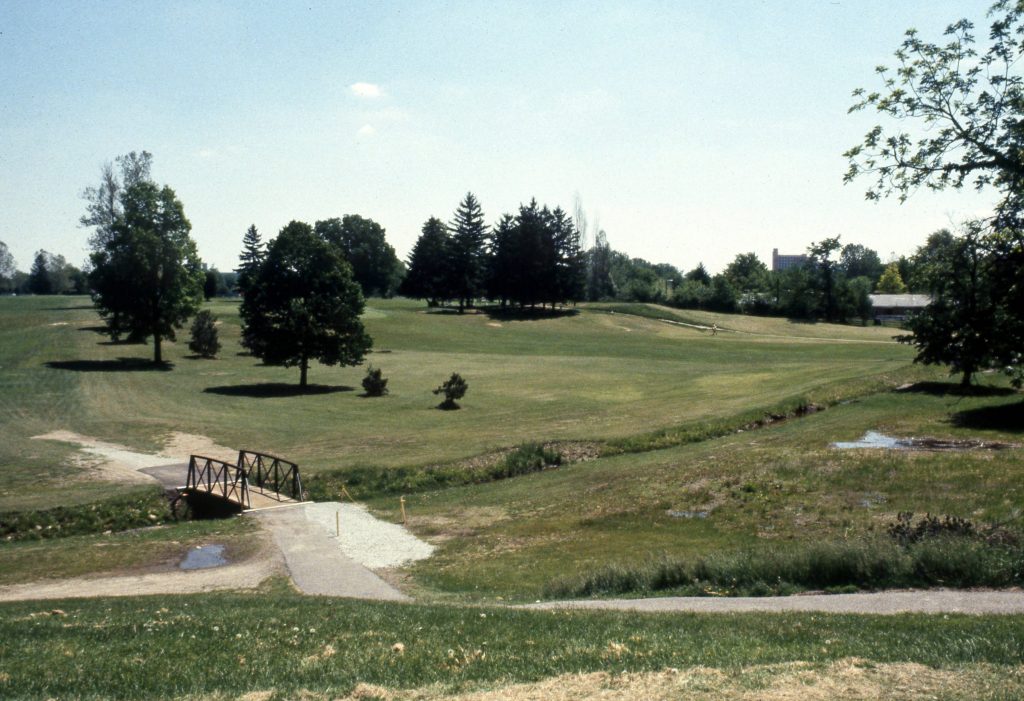
(1884–Feb. 25, 1985). William Hickman Diddel designed, redesigned, or built more than 300 golf courses throughout the US in his lifetime. His most notable works, located predominantly in Indiana and other midwestern states, include Indianapolis’s Meridian Hills, Hillcrest, and Woodland ; Riverside and Coffin municipal golf courses within ; and Fort Benjamin Harrison golf course (see ). Diddel’s work exemplified the principles of the “strategic school” of course design, a style that emphasized thoughtful planning for the envisioned golfer, varied shots, and strategic challenges. Diddel’s designs were a staple of the “golden era” of golf course design, a period marked by the rise of public courses and an increasing national interest in the sport. Diddel strove to balance complex challenges with awareness that, in his words, “the average club has about five golfers who want a tough course.”

Diddel was born in Indianapolis and graduated from in 1904. While there he ran indoor track and played baseball, basketball, and football. In 1903, during his junior year of high school, he won the Indiana amateur golf championship, a title he would earn five more times between 1905 and 1912. Diddel graduated in 1908 from Wabash College, becoming that institution’s first graduate to letter in four sports: track, football, baseball, and basketball. After graduation, he worked in the life insurance business until 1914, when he returned to Wabash to serve as the athletics, alumni, and admissions directors.
He returned to Indianapolis in 1917 to manage the Franklin Motor Car Company (see ) alongside his brother Glenn Diddel. In 1922, Diddel’s passion for golf led him to his longtime career as a golf course architect. Among his most celebrated works was the expansion of Indianapolis’s Sarah Shank Golf Course in 1941. Initially opened as a nine-hole course in 1927, Sarah Shank became noteworthy among local golf enthusiasts. Southside golfers had been clamoring for an 18-hole course on their side of town since 1934. The opportunity to create one at Sarah Shank came after the Works Progress Administration (WPA) appropriated part of the 9-hole course along the for a flood control project. The city, in response to the WPA plan and requests by local golfers, purchased 37 acres on the northwest edge of the original course to expand it to 18 holes. Diddel was hired to design the expanded and reconfigured course, marking a significant moment in the growth of public golf facilities in Indianapolis, whose popularity had grown as the sport accumulated a greater US following during the 1920s and 1930s. Though improvements have been made to the course over the years, the overall design remains consistent with Diddel’s intent.

Diddel’s influence extended beyond local projects. He was a founding member of the American Society of Golf Course Architects and served as its president in 1950 and 1965. The first course he designed and built was Woodland on East 116th Street in , Indiana. Though the course opened as a public fee course, he and other interested golfers organized the course into a private country club called Woodland Country Club in 1956. His legacy in the field of golf course architecture was cemented when he was inducted into the Golf Hall of Fame in 1964. Though many of his designs have been altered or destroyed over time, Diddel’s impact on the landscape of Indiana and the Midwest is still felt, particularly at courses like Sarah Shank, which remains a rare example of his enduring “strategic school” design.
Diddel’s legacy is evident not just in his numerous designs but also in his philosophy that golf should be accessible and enjoyable for all. His contributions to the sport continued to inspire and influence golf course architects well into the twenty-first century.
FURTHER READING
- American Society of Golf Course Architects. “William H. Diddel.” https://asgca.org/architect/wdiddel/.
- Ron, Kern. “William H. Diddel.” Ron Kern Golf Course Architect, May 17, 2012. https://ronkerngolfarchitect.wordpress.com/william-h-diddel/.
CITE THIS ENTRY
APA:
Johnson, S. (2025). William H. Diddel. Encyclopedia of Indianapolis. Retrieved Jan 2, 2026, from https://indyencyclopedia.org/william-diddel/.
MLA:
Johnson, Spencer. “William H. Diddel.” Encyclopedia of Indianapolis, 2025, https://indyencyclopedia.org/william-diddel/. Accessed 2 Jan 2026.
Chicago:
Johnson, Spencer. “William H. Diddel.” Encyclopedia of Indianapolis, 2025. Accessed Jan 2, 2026. https://indyencyclopedia.org/william-diddel/.

Help improve this entry
Contribute information, offer corrections, suggest images.
You can also recommend new entries related to this topic.